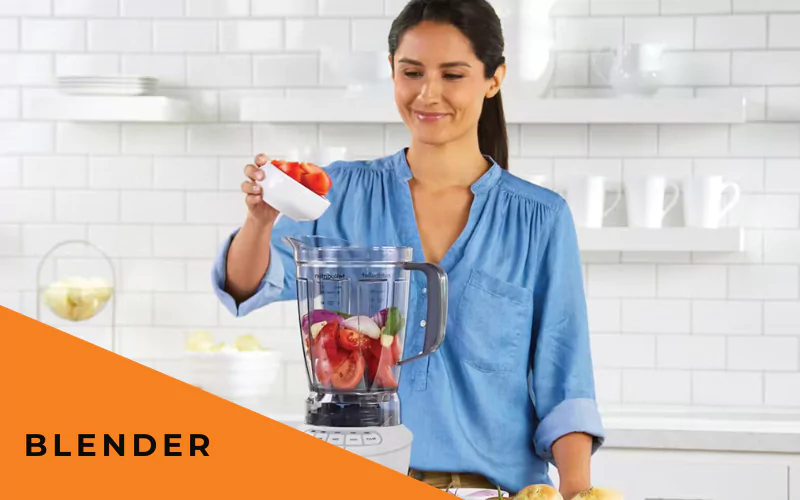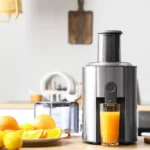How To Juice Without A Juicer: A Comprehensive Guide
Have you ever craved a glass of fresh, homemade juice but found yourself without a juicer? I certainly have. The problem is, traditional juicers can be expensive and take up a lot of space in the kitchen. However, there’s no need to worry because I’ve discovered an easy and affordable solution to this dilemma ‘’How to juice without a juicer?’’
In this blog post, I’ll share my personal experience and guide you through the process of juicing without a juicer. You’ll be surprised at how simple and enjoyable it can be to create your own delicious juices at home using basic kitchen tools.
What You Need To Make Juice Without A Juicer?
Before you know how to juice without a juicer, it’s important to have an idea of the essential tools and ingredients needed for the process. Here’s a comprehensive guide on how to make juice without a juicer.
Blender

A high-speed blender is essential for juicing without a juicer. It helps in breaking down the fruits and vegetables into a smooth consistency, resulting in a juice-like texture.
Cheesecloth or Nut Milk Bag

These are used for straining the blended fruits and vegetables to separate the juice from the pulp, resulting in a smooth and pulp-free juice.
Fruits and Vegetables

Choose fresh, ripe fruits and vegetables for juicing. Some popular options include apples, carrots, oranges, kale, spinach, cucumbers, and beets.
Liquid

Adding a small amount of liquid such as water or coconut water can help in the blending process and adjust the consistency of the juice.
Sweeteners (Optional)

If desired, natural sweeteners like honey, agave nectar, or maple syrup can be added to enhance the flavor of the juice.
How To Juice Without A Juicer?
When it comes to juicing without a juicer, I have found that there are several methods to extract juice from various fruits and vegetables. Here’s how I do it:
Orange Juice
When making orange juice without a juicer, I start by cutting the oranges in half and using a citrus reamer or a fork to extract the juice. Alternatively, I can also use a blender or food processor to blend the peeled oranges and then strain the mixture through a fine mesh sieve or cheesecloth to separate the juice from the pulp.
Lemons
For lemons, I simply roll them on a hard surface to soften them before cutting and squeezing them by hand or using a citrus juicer.
Apples
To juice apples without a juicer, I chop them into small pieces and then blend them with some water in a blender. After blending, I strain the mixture through a nut milk bag or cheesecloth to separate the juice from the pulp.
Oranges, Ginger , Carrot ,Pineapple, Watermelon, Pomegranate, Beets, And Tomatoes
For these fruits and vegetables, I use a similar method of chopping them into smaller pieces and then blending them with some water. After blending, I strain the mixture through a fine mesh sieve or cheesecloth to extract the juice.
How To Juice Greens Without A Juicer?
In terms of greens, juicing without a juicer can be achieved through various methods. Here’s how I juice greens without a juicer:
Celery
I start by washing the celery thoroughly and then chopping it into small pieces. Then, I use a blender or food processor to blend the celery until it becomes a smooth puree. After that, I strain the puree through a fine-mesh sieve or cheesecloth, pressing down to extract the juice.
Kale
Similar to celery, I wash the kale leaves and remove the tough stems. Then, I blend the kale with some water in a blender until it reaches a smooth consistency. Finally, I strain the mixture to separate the juice from the pulp.
Kiwi
To juice kiwi without a juicer, I peel the kiwi and cut it into chunks. Then, I use a blender to puree the kiwi until smooth. Afterward, I strain the puree through a fine sieve or cheesecloth to extract the juice.
Grapes
For grapes, I wash them thoroughly and remove the stems. Then, I place them in a blender and blend until smooth. The resulting mixture is strained through a fine-mesh sieve or cheesecloth to obtain the juice.
Cabbage
When juicing cabbage without a juicer, I chop the cabbage into small pieces and blend it with some water in a blender. Then, I strain the mixture through a fine sieve or cheesecloth to separate the juice from the pulp.
Cucumber
To juice cucumber, I start by washing and chopping it into chunks. Then, I blend it with some water until smooth. Finally, I strain the mixture through a fine-mesh sieve or cheesecloth to extract the juice.
Pears
After washing and removing the seeds from the pears, I chop them into pieces and blend them with some water in a blender. Then, I strain the mixture through a fine sieve or cheesecloth to obtain the pear juice.
Peach
Similar to pears, I wash and remove the pit from peaches before blending them with water in a blender. The blended mixture is then strained through a fine-mesh sieve or cheesecloth to extract the peach juice.
Spinach
For juicing spinach without a juicer, I wash the spinach leaves thoroughly and blend them with some water in a blender until smooth. Then, I strain the mixture through a fine sieve or cheesecloth to separate the juice from the pulp.
Wheatgrass
When juicing wheatgrass without a juicer, I start by washing it thoroughly and then blending it with some water in a high-speed blender until smooth. Finally, I strain the mixture through a fine-mesh sieve or cheesecloth to obtain the wheatgrass juice.
How To Make Vegetable Juice Without A Juicer?
Well, making vegetable juice without a juicer is a simple and cost-effective way to enjoy the benefits of fresh, homemade juice. As someone who enjoys a healthy lifestyle, I have often found myself wanting to make vegetable juice without a juicer. Here’s how I do it.
Selecting the Vegetables
I start by selecting a variety of fresh vegetables such as carrots, cucumbers, spinach, kale, and celery. These vegetables are rich in vitamins, minerals, and antioxidants, making them ideal for juicing.
Preparation
After washing the vegetables thoroughly, I chop them into smaller pieces to make them easier to blend. This also helps ensure a smoother consistency in the juice.
Blending
I then add the chopped vegetables to a high-speed blender along with a small amount of water. I blend the mixture until it becomes smooth and liquefied. To extract the juice from the pulp, I strain the blended mixture using a fine-mesh strainer or cheesecloth.
Flavor Enhancement (Optional)
To enhance the flavor of the vegetable juice, I sometimes add a splash of lemon juice or a small piece of ginger before blending. This adds a refreshing twist to the juice.
Storage
Once the juice is ready, I pour it into a glass container and store it in the refrigerator. It’s best to consume the juice within 24 hours to retain its freshness and nutritional value.
How To Do A Juice Cleanse Without A Juicer?
When I wanted to do a juice cleanse but didn’t have a juicer, I found alternative methods to still achieve my goal. Here’s how I did a juice cleanse without a juicer:
Use a Blender
I used a high-powered blender to make my juices. While the texture might be slightly different from that of a juicer, it still worked well. I made sure to chop the fruits and vegetables into smaller pieces to ease the blending process.
Strain the Mixture
After blending the fruits and vegetables, I strained the mixture using a fine mesh strainer or cheesecloth to separate the juice from the pulp. This extra step ensured that my juice was smooth and free of any solid particles.
Add Water if Needed
Sometimes, using a blender can result in a thicker juice consistency. To adjust this, I added a small amount of water to dilute the mixture to my desired consistency.
Plan Ahead
Since using a blender takes more time and effort compared to a juicer, I made sure to plan ahead and prepare the juices in advance. This helped me stay consistent with my cleanse without feeling overwhelmed.
Stay Hydrated
During the cleanse, it’s essential to stay hydrated by drinking plenty of water alongside the juices. Hydration is key to supporting the body during a cleanse.
How To Make V8 Juice With A Juicer?
I love making my own V8 juice at home using a juicer. It’s a great way to ensure that I’m getting all the nutrients from fresh vegetables in a delicious and convenient form. Here’s how I make V8 juice with a juicer:
Ingredients
- 4 large tomatoes
- 2 large carrots
- 3 stalks of celery
- 1 red bell pepper
- 1 small beet
- 1/4 of a small onion
- 2 cloves of garlic
- A handful of spinach or kale
- Salt and pepper to taste
Instructions
- Wash all the vegetables thoroughly.
- Cut the tomatoes, carrots, celery, and red bell pepper into pieces that will fit into your juicer chute.
- Peel the beet and cut it into smaller pieces.
- Peel the onion and garlic.
- Start by juicing the softer vegetables like tomatoes, followed by the harder ones like carrots and beets.
- Add the spinach or kale in between to help push through any remaining bits of vegetables.
- Once all the vegetables are juiced, stir the mixture well and add salt and pepper to taste.
- Pour the juice into a glass and enjoy!
What Is the Blender Method?
Know that, the blender method in juicing involves using a high-speed blender to process fruits and vegetables into a smooth liquid. I have found that this method retains more fiber compared to traditional juicing, as the entire fruit or vegetable is used, resulting in a thicker and more filling juice. Additionally, the blender method allows for greater flexibility in terms of ingredients and can be a convenient way to incorporate more nutrients into my diet.
How To Juice With A Blender?
When you are using different blenders, the process of juicing without a juicer can vary slightly. Here’s my personal experience with using the Ninja Blender and the Vitamix Blender to juice without a juicer.
Ninja BN701 Professional Plus Bender
When using the Ninja BN701 Professional Plus Blender for juicing without a juicer, I found that it’s essential to start by preparing the fruits and vegetables. I typically chop them into smaller pieces to ensure that they blend smoothly. Once the ingredients are ready, I add them to the blender along with a small amount of water. It’s important not to add too much water, as this can dilute the juice.
After adding the ingredients, I use the blender’s pulse function to start breaking down the fruits and vegetables. Then, I blend the mixture on high speed for about 1-2 minutes until it reaches a smooth consistency. Once blended, I strain the mixture through a fine-mesh sieve or nut milk bag to separate the juice from the pulp. The resulting liquid is a fresh and vibrant juice that can be enjoyed immediately.

Vitamix Professional Series 750, 64 Oz Blender
When using the Vitamix Professional Series 750, 64 Oz Blender for juicing without a juicer, I follow a similar process of preparing the ingredients by chopping them into smaller pieces. The powerful motor of the Vitamix blender allows for efficient blending, so I add the ingredients along with a small amount of water and start at a low speed before gradually increasing to high speed.
I typically blend the mixture for about 1-2 minutes until it becomes smooth and well combined. Similar to using the Ninja blender, I then strain the mixture through a fine-mesh sieve or nut milk bag to extract the juice from the pulp. The result is a nutrient-rich juice that retains all the flavors and goodness of the fresh produce.

What Is the Citrus Press Method?
Last but not least, when it comes to juicing, the citrus press method is my go-to technique for extracting juice from fruits like lemons, limes, and oranges. I place the halved fruit onto the reamer of the citrus press and then firmly press down, allowing the juicer to extract the maximum amount of juice while filtering out the seeds and pulp. This method not only ensures that I get every last drop of juice from the fruit but also makes the juicing process quick and efficient. The resulting fresh citrus juice is perfect for adding a burst of flavor to recipes or enjoying on its own.
Conclusion
In conclusion, juicing without a juicer is entirely possible and can be achieved using various alternative methods such as using a blender, food processor, or even a nut milk bag. By following the comprehensive guide provided, individuals can enjoy the benefits of fresh, homemade juices without the need for specialized equipment. Experimenting with different fruits, vegetables, and combinations can lead to a wide array of delicious and nutritious juice options.
FAQs
Can You Juice Things Without A Juicer?
Yes, you can juice without a juicer by using a blender or manually extracting juice from fruits and vegetables.
How To Make Juice At Home Without A Machine?
To make juice at home without a machine, blend or squeeze fruits and vegetables, and strain the liquid.
How Do You Juice By Hand?
Juicing by hand involves manually extracting juice from produce using tools like a citrus reamer or press.
Can You Use A Blender For Juicing?
Using a blender for juicing is possible; blend fruits and veggies, then strain the mixture to separate the juice from the pulp.
What Should I Do With The Leftover Pulp?
Repurpose leftover pulp by adding it to recipes like muffins, soups, or composting for added fiber and nutrients.
Can I Make This Recipe In A Juicer If I Have One?
If you have a juicer, you can use it for the recipe by following the machine’s instructions.
How Often Should I Drink This Juice?
The frequency of drinking juice depends on personal preferences and dietary needs; aim for moderation and balance in your overall diet.

Rebecca Wojcik
Rebecca Wojcik, a highly skilled and accomplished nutrition expert, is an experienced Registered Dietitian Nutritionist, Registered Yoga Teacher (200 hr), and successful female entrepreneur.






